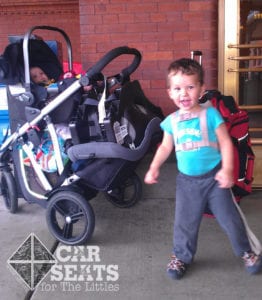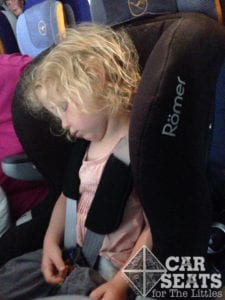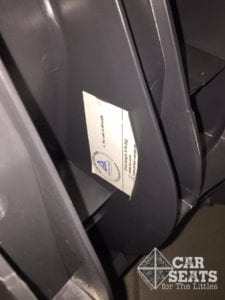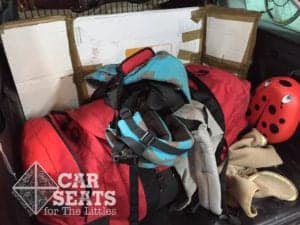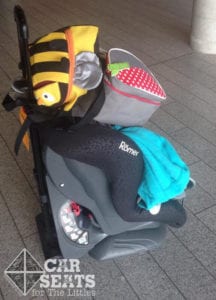We’re always excited to add contributors to the CSFTL team. This article comes to us from across the pond! Please welcome our brand new, fabulous European correspondent Caitlin!
Tickets? Check. Favourite stuffed animal? Check. Passports? Check. Car seat? Wait, what? How in the world are you meant to transport your child’s car seat across Europe?
When it’s time to set off on your holiday adventure, the prospect of lugging a big, heavy car seat with you can be more than a bit daunting. But it’s still the best way to keep your child safe. Unlike rental car seats, you know the history of your own car seat, you should be familiar with the install, and you know it’s appropriate for your child.
Southern or Eastern Europe
Keep in mind that if your destination is Southern or Eastern Europe and you plan to rent a car, you may get an older model vehicle that doesn’t have ISOFIX or top tethers. It’s best to confirm with the rental company the year and model of vehicle before you travel so you can be sure your car seat will fit.
Air Travel
Unlike American and Canadian airlines, European-based air carriers are under no obligation to allow car seats on board. The governing bodies that oversee air travel in Europe have not yet drafted any regulations regarding car seat usage. However, most airlines do have policies outlined regarding child seats, though the policies can range from extremely accommodating to outright refusals to allow them on board.
It’s always a good idea to check the airline’s specific policy, call or email them to confirm the use of your child restraint on board, and print any relevant documentation to bring with you and show staff if you are questioned. Whenever possible, the best option is to use a car-seat friendly airline. Here are the car seat policies of some of the major European carriers:
Air Certified Car Seats
Once you book a ticket with a car-seat friendly airline, you also need to have an air-certified car seat. Unlike American car seats, which are almost all certified for airline travel, European seats generally aren’t. TÜV Rheinland is the body that certifies car seats for air travel, and they maintain a list of approved car seats.
Note: not all of the car seats in the group 1 category will be accepted by airlines. Many of them use impact shields, and most airlines that allow car seats on board require that seats be both approved AND use a 5-point harness. That effectively limits the approved toddler seats to the Britax Eclipse and the Diono Radian 5 (the King Quickfix has been discontinued for some time). Both models must be used forward facing on the plane; the Radian 5 can be installed rear facing in a vehicle, but the Eclipse is forward-facing only. If your seat is TÜV certified for air travel it will have a sticker somewhere on the seat stating its approval.
Checking a Car Seat
Sometimes it just isn’t possible to fly with your child sitting in their car seat. While it is always preferable for them to be safe and secure in their seat, when that just isn’t possible you still need to take extra care with their car seat and pack it up safely.
Most airlines will allow you to check a car seat for free, but be sure to package it securely to help prevent damage in transit. The original box it came in is generally the best bet for optimum protection, but if that isn’t available another large, sturdy cardboard box can also work. Wrap the seat in bubble wrap, then place it in the box. Don’t seal it up yet, though! Airlines often want to be sure you aren’t “smuggling” extra luggage with your car seat, so they may check to be sure there is nothing else in the box. Bring some tape with you so you can seal the box after they check the contents. On the other end, you can dismantle the box, flatten it, and store it until the return trip. Keep in mind that many airlines take no responsibility for lost or damaged car seats, so checking one is at your own risk!
Travel by Train
Trains are some of the more comfortable, safe travel options for kids. While there are no seat belts or ISOFIX anchors and thus no way to install your child’s car seat, trains have excellent safety records and can be a great choice for kids who don’t want to sit restrained for hours on end. You can generally take your car seat on board and store it with other oversized luggage, often in specified luggage racks.
Local Buses
Local buses don’t have seat belts or ISOFIX anchors, so you can’t install your child’s seat onboard. However, due to their lower speeds, fixed routes, and large size, local buses are a very safe mode of transportation.
Long-Distance Rides
Long-distance buses and coaches, which travel at motorway speeds between cities, are a bit trickier for children. Some have seat belts available, but not all are suitable for car seat installation. It’s best to check with the bus company before you travel to ensure that lap-shoulder belts are available. Retractable lap-only belts are not generally suitable for car seat installation. It’s best to avoid long-distance coaches that don’t have suitable belts for car seats.
Other Options
If you babywear, a buggy can be a convenient way to transport a car seat — even stack multiple on top, depending on the seats — or you can purchase a dedicated car seat trolley. Some trolleys even allow kids to sit in them while you pull them, much like a buggy.
No matter how you travel, be sure to keep your car seat within sight whenever possible, or safely boxed when it needs to be away from you. And, most of all, enjoy your trip!

